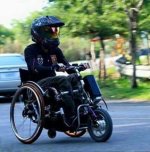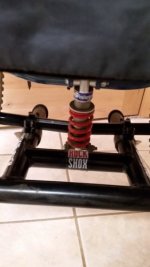This chart is the test data from a dyno pull and shows the raw motor performance data. The 'lbs thrust' information you are requesting can be derived but also reflects characteristics of the vehicle controller, drive system, and wheel - not the motor alone.spdas said:To me the chart would be meaningful it they had another column showing 1 pounds of load requiring x amps, and producing y rpm,, then 2 pounds load requiring 3x amps, 4y rpm etc.
For the test, the motor is rigged to a braking device and to a controller that has enough capacity to not introduce any limiting. The motor is spun up with no load (max rpm) and the brake applied to progressively load the motor. The Nm column shows the torque developed due to braking, the other columns show the resulting rpm, current draw, etc under increasing load. As the braking torque increases, the rpm drops and the current goes up. The reported efficiency in these charts is difference between the electrical power in (V x A) and mechanical power out (torque x rpm). Physics - not a lot of room for interpretation...
From this 'motor only' data you can apply any wheel size and gearing you want to calculate the lbs thrust and resultant speed for no-controller-limited operation. From a vehicle perspective, however, the controller actually introduces limiting under load which causes the available mechanical power to be artificially constrained as the input power is curtailed by the controller. This diverges from what the chart indicates.
If you plot this data for a particular wheel size with speed on the X-axis (from the rpm and wheel size), you will get the more familiar plot that you see in the ebikes.ca simulator (without any controller effects - as if you specified an 1000A controller).
So - the chart shows the raw motor performance without consideration for other vehicle design factors. If you want to know the lbs-thrust at some particular rpm and current, you need to do some math and consider all the other parts of your vehicle - not just the motor.






